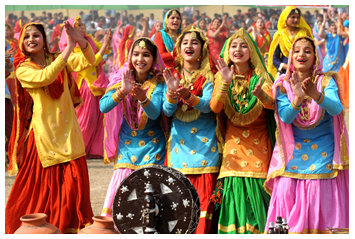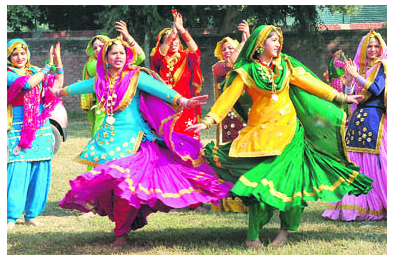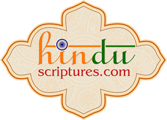DANCE FORMS OF PUNJAB
Contents
· Introduction
· Folk Dance
· Bhangra
· Giddha
· Sammi
· Kikli
· Karthi
· Jhumar
· Folk Music
Introduction
Located in the Northern part of India, Punjab is the 15th largest state of India. The state is rich in culture and art. Music and dance plays a very significant role in the lives of Punjabis and their rhythmic movement and colourful dresses are extremely popular. Some of the most popular dance forms of Punjab are Bhangra, Dankara Julli, Luddi, Jhumar, Giddha, Jaago, Dhamal, Gatka and Kikli.
Folk Dance
Folk dance is also one of the most significant aspects of Punjabi lifestyle. It is essentially an expression of emotions and is devoid of any form of superficiality. There are no certain rules for the dances and therefore any gesture is considered as appropriate, as long as the dance synchronises with the subtle expressions of emotions. No special costumes or props are required for the performance. All sects, castes and creed are allowed to participate in the dance. The Dhol or drum is the main instrument accompanying the dance. Men and women dance in separate groups, during the performance. Bhangra and Giddha are the most popular folk dances of Punjab.
Bhangra
The Bhangra is performed on the occasion of Baisakhi or any other significant social occasion. During this period, the harvesting season is usually over and fairs are organised all across the state. The origin of this dance form is associated with ancient fertility rites.
There is no prescribed dress code for Bhangra, however, dancers usually wear shirts having loose sleeves, stiff-starched tahmats (loose loin clothes reaching up to the ankles) and brightly colored waist coats. Sometimes, tiny bells are attached to the ankles and bright, stone-embedded strips are worn over the turbans.
Bhangra is directly associated with sheer stamina and force. The drummers usually stand at the centre of the circle formed by the dancers. Slowly and steadily the drummer increases the tempo and there is a simultaneous increase in the tempo of dancing, until the dancers are exhausted. The exhausted dancers are replaced by another group of dancers. The dance is accompanied with chants of ‘Hoy Hoy’ and ‘Balle Balle’. This cycle may extend for hours. Bhangra is steadily losing its rural roughness and originality of character and is becoming more and more sophisticated in its steps.
Giddha
Giddha is the most popular folk dance for women in the state of Punjab. The Giddha performed during marriage ceremonies is called Viyahula Giddha and that performed during Teeyan is called Teeyan Giddha. Giddha is performed in a much similar manner to the Bhangra i.e. one of the performers comes forwards and chants the Boli and then later all the others picks up the rhythm. Different acts are enacted during the performance such as playing the role of a quarrelsome mother-in-law, submissive wife etc. Kikli is also performed in groups of two, by the performers. Swings are also put up under Banyan trees and the women dance and swing to their hearts content.
Sammi
Sammi is a dance for women and is very simple to perform. In this form of dance, the dancers usually form a circle and swing their arms in different movements. The swinging of the arms is interspersed with clapping and tapping of the feet. The rhythm is maintained throughout, by clapping and feet movements. Usually, there are no musical instruments accompanying the dance. The dance has been named after the legendary heroine, Sammi, who sang and danced in anticipation of her beloved.
Kikli
The Kikli dance form is especially popular among the younger girls. During the performance, girls forming pairs stand facing each other, with their hands held crosswise. Holding onto each other, they start swinging on their toes. The swinging momentum gathers and continues until it reaches the point of exhaustion. This fast swinging around creates a sense of ecstasy among the dancers and the swinging rhythm is accompanied by singing on various subjects such as father, mother, mother-in-law etc.
Karthi
In the state of Punjab, Karthi is the only dance form, in which both men and women perform together. Before the performance, offerings are made to a deity, at the time of harvest. The women lead the processions and singing, and is followed by men. Then, both men and women perform by alternating and linking hands with each other, which is done in tandem with the accompanying songs about sentimental stories such as battles fought, union and quarrels of lovers etc. This also the only dance form, which is accompanied by an instrument, known as Folk Shehnai. The tempo of this dance form is also lesser than that of Bhangra and Giddha.
Jhumar
Jhumar is essentially the folk dance of the harvest season and it recreates the activities associated with the farming process. The movements of the dance depict the movement of rearing animals, ploughs, farmers and the process of harvesting. At the climax of the dance, the dancers rejoice around in circles, in a much similar manner to the Bhangra.
Folk Music
Punjabi folk music reflects the unsophisticated lifestyle of the Punjabi villagers, which is essentially in tune with their deeply felt emotions. The rhythms and beats of the music are very basic in content and characteristic. The tune and melodies keeps changing in accordance with the region. Dholaks are very popularly used to accompany the folk songs. Dholaks are sometimes replaced by earthen pots and are played upon with small pieces of stones to create various percussion sounds. Other popular instruments are Algozha, Iktara and Daad Sarangi. The popular folk tunes are Mahiya, Boli and Dhola. The triplets of Mahiya are also known as Tappa. Loris or Lullabies are also very popular in the state of Punjab. Numerous tales and folklores are also associated with the state of Punjab such as the tales of Gopi Chand, Puran Bhagat, Jeuna Mor, Hakeekat Rai, Mirzasahiban, Sassi Punnu, Heer Ranjha and Sohni Mahiwal.



